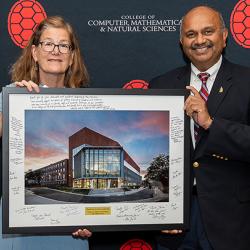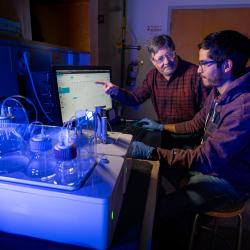Professor YuHuang Wang Named Fellow of the American Physical Society
The honor recognizes Wang’s significant contributions to materials science
University of Maryland Chemistry and Biochemistry Professor YuHuang Wang has been named Fellow of the American Physical Society (APS). The prestigious honor recognizes APS members who advanced physics through original research and publication or made significant innovative contributions in the application of physics to science and technology.
“We are extremely proud of YuHuang for this well-deserved recognition,” said Janice Reutt-Robey, chair of UMD’s Department of Chemistry and Biochemistry. “YuHuang harnesses chemistry to create new materials with unique physical properties. He synthesizes carbon-based materials with tunable optical properties and structures that are of fundamental importance. His cutting-edge measurements of their emergent properties demonstrate their immense potential for breakthrough technologies in the quantum, energy and biotechnology sectors. The American Physical Society names only a small percentage of their members as Fellows, and this is truly a distinct honor for a chemist.”
Wang was recognized for his “distinguished contributions to the fundamental chemical physics of single-walled carbon nanotubes and its applications, notably the development of molecularly tunable fluorescent quantum defects for photo-actuated imaging, sensing and patterning.”
“I was very surprised to hear I had been nominated and elected to become an APS Fellow,” Wang said. “This is quite an honor, and I am very grateful to the APS for this recognition of my work and to those who have supported my research throughout my career. This recognition is a reflection of the hard work of everyone in my lab and the importance of this new frontier in quantum materials.”
The APS recognition acknowledges Wang’s discovery and development of organic color-center quantum defects, which provide new insights into the fundamental physics and chemistry of materials.
Wang’s research focuses on carbon nanotubes—tiny tubular structures made of carbon atoms chemically bonded into a hexagonal lattice. Scientists have known for decades that irregularities or “defects” can occur on the surface of nanotubes when another molecule or atom attaches to one of the carbon atoms in the lattice. (Think of it like a tiny bump on the surface of a glass straw.) These atomic defects modify the surface properties of the carbon nanotubes. For example, a defect may make the surface of the nanotube attract or repel water or interact more readily with other molecules. However, it was long believed that such defects also degraded the electronic properties of these materials.
Wang discovered that these defects can create completely new properties that are beneficial and unlike the properties of either the nanotube or the molecule attached to it. These defects have demonstrated a series of fascinating chemical and physical properties, and they can be made to emit bright near-infrared photons one at a time, even at room temperature. Scientists call these intentionally introduced defects “quantum defects” and “organic color-centers” to emphasize their quantum and organic aspects, respectively.
Wang’s work has broad applications, and new applications are rapidly emerging. In medical imaging, organic color-centers could significantly increase the brightness of nanotubes that are being developed as near-infrared probes for high-resolution deep-tissue imaging. In quantum information science, quantum defects may provide bright quantum light sources for solid-state quantum computing and communication systems, which have so far been hard to control and scale. And in sensing technology, Wang uses a combination of surface chemistry and quantum properties of the defect sites to develop tools that will be sensitive and selective enough to detect a single molecule. Such tools could be useful in detecting cancers and certain disease states.
“Many people around the world are working in this area now. In a short period of time, we have collectively created several dozen new color-centers,” Wang said. “And this is just the beginning. Virtually every single molecule now holds the potential to create a unique color-center where chemistry and physics meet in unexpected ways.”
Wang joined UMD in 2008 after completing a postdoctoral fellowship at Northwestern University with Chad Mirkin. He earned his B.S. in chemistry from Xiamen University and his Ph.D. in chemistry from Rice University where he studied under the late Nobel laureate Richard E. Smalley.
Wang received a National Science Foundation (NSF) Faculty Early Career Development (CAREER) award in 2011 and UMD’s Kirwan Faculty Research and Scholarship Prize in 2019. He has received consistent support from multiple federal funding agencies, including the NSF and the U.S. Department of Energy (DOE). He currently serves as the deputy scientific director of the Center for Enhanced Nanofluidic Transport (CENT). An Energy Frontier Research Center funded by DOE’s Basic Energy Sciences program, CENT brings scientists from a range of disciplines together to collaborate on fundamental studies of fluidic flow and molecular transport with the goal of establishing the scientific foundation for new water purification and chemical separation technologies.
Wang joins four other UMD faculty members named APS Fellows in 2021.
Written by Kimbra Cutlip






